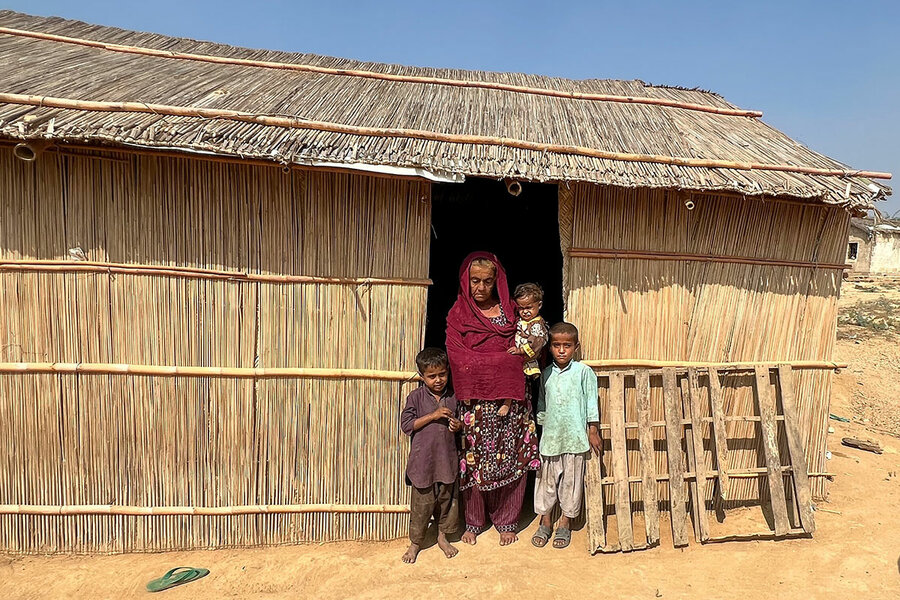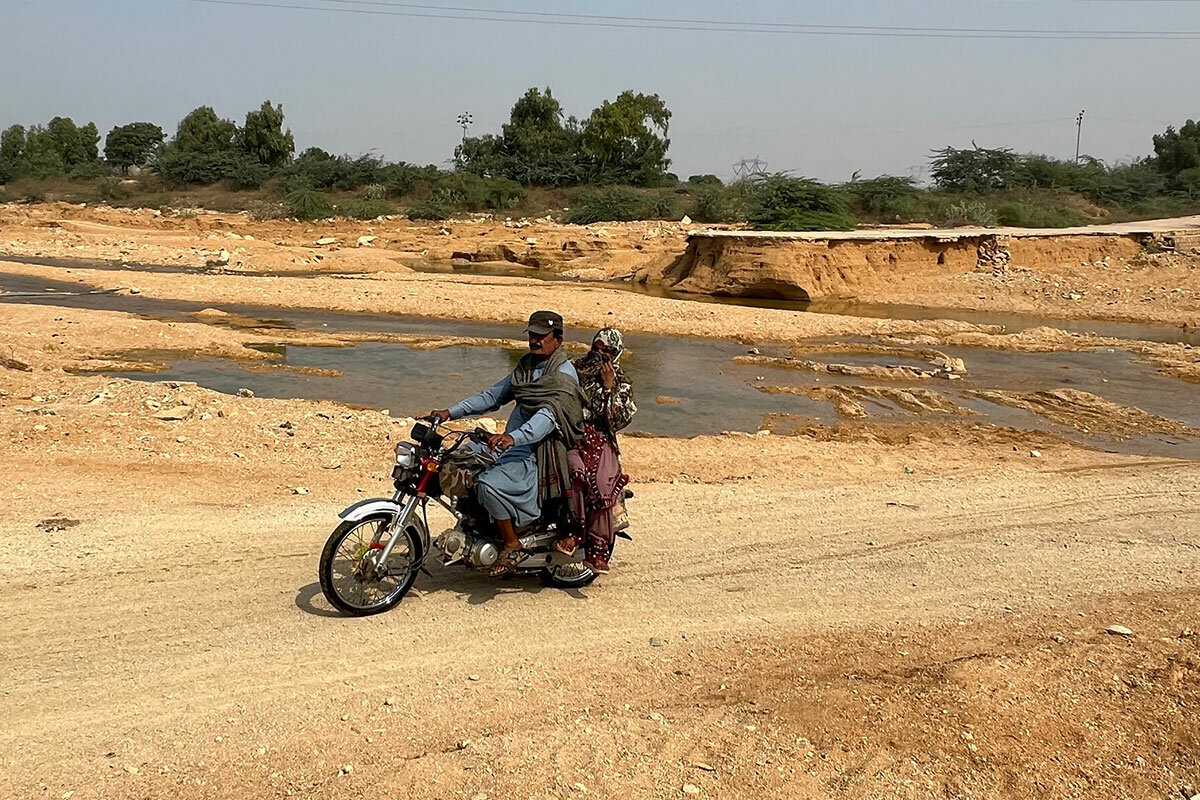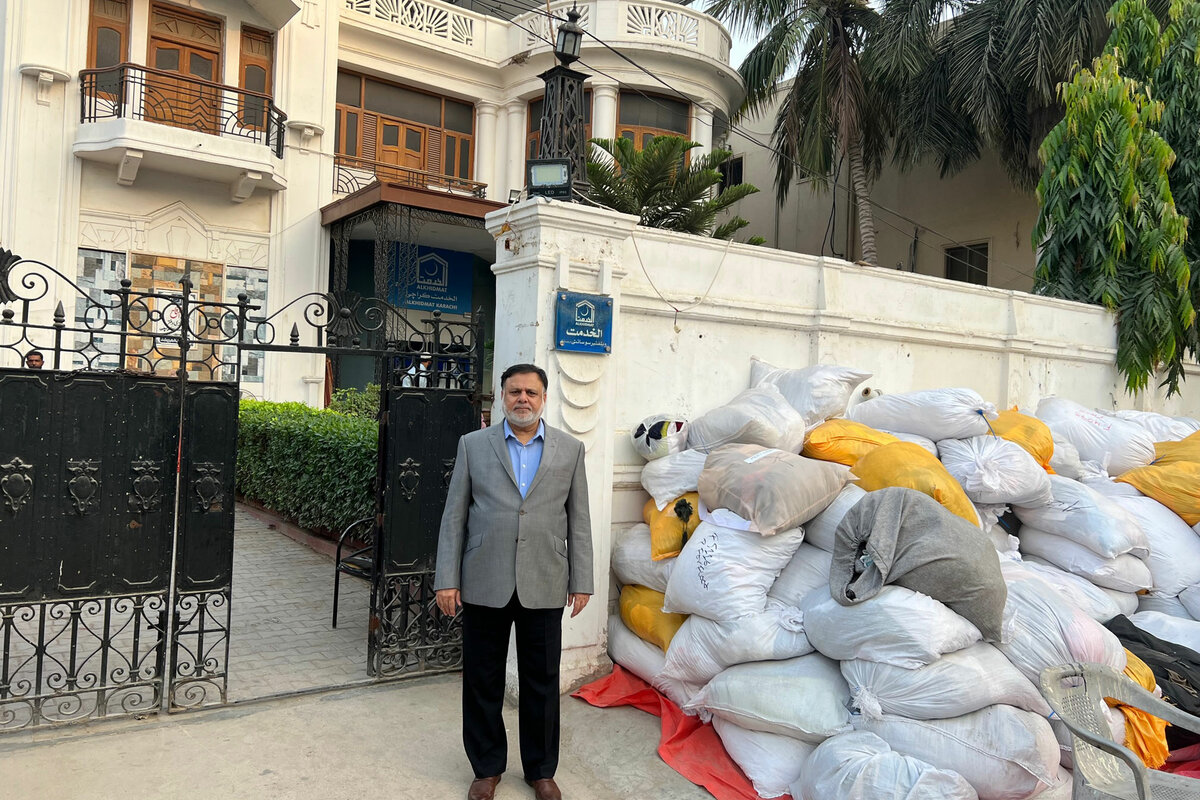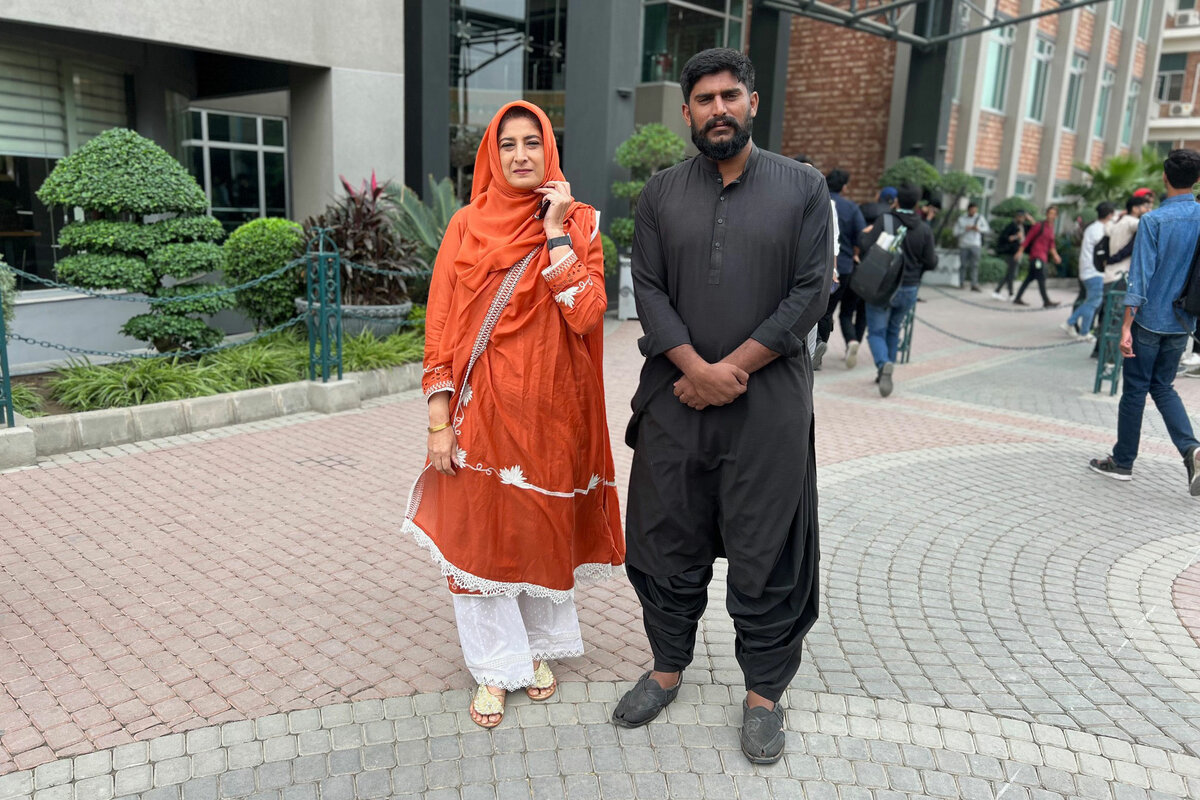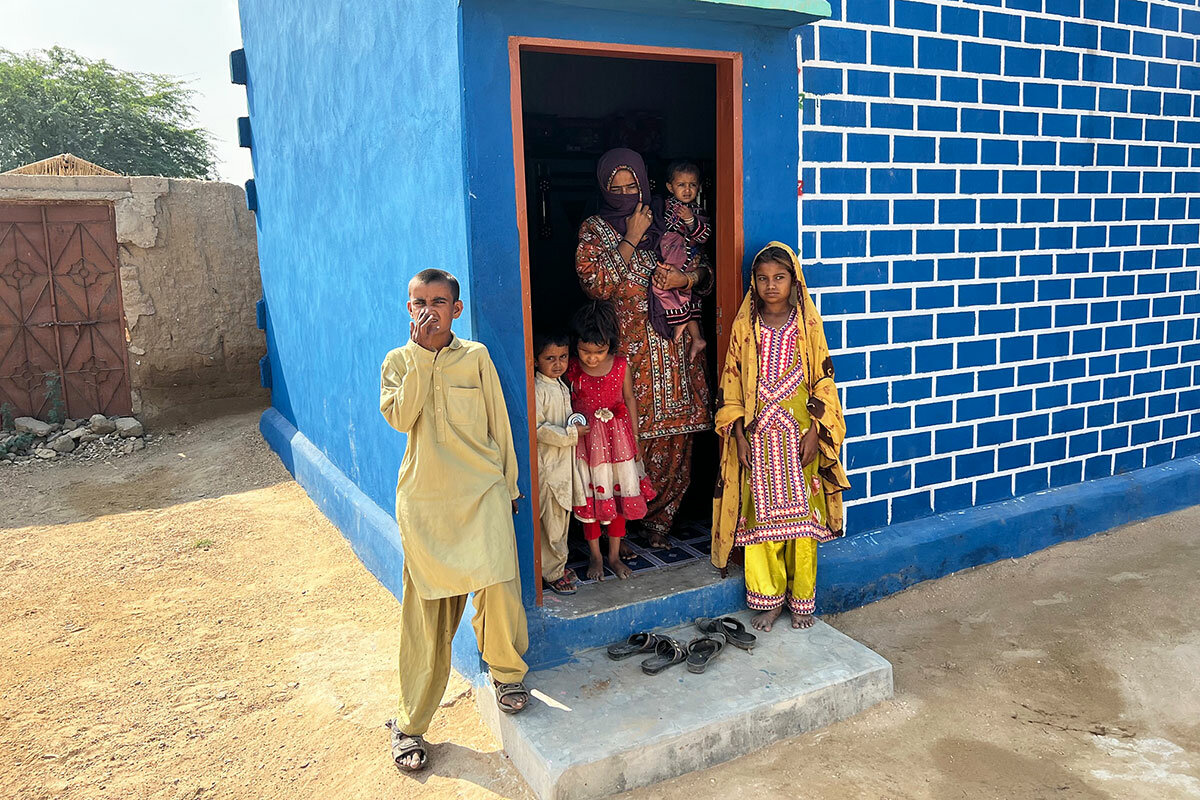What would a climate-resilient Pakistan look like? Sindh offers clues.
Loading...
| GADAP, PAKISTAN
When unrelenting flood waters hit the small, hardscrabble village of Mir Khan-Goth in Pakistan’s Sindh province last August, Seema had no idea how a life that had carried on in familiar patterns over many decades was about to change.
First, the powerful tide of earth-laden water carried away Seema’s daughter, who had ventured out into a thigh-high river to salvage any food she could at the outdoor kitchen. She would never return, leaving Seema, who offered only her first name, to care for her four grandchildren.
But the floods also left the family’s traditional thatched, one-room hut roofless and teetering – no match for the weeks on end of unprecedented rains that followed the floods. Scientists say that pattern is likely to repeat with climate change fueling increasingly extreme weather. Like more than half of the 50 thatched or earthen houses that made up Mir Khan-Goth before this year’s monsoon rains, Seema’s house was suddenly no longer a refuge, but a trap.
Why We Wrote This
A story focused onIn Pakistan’s flood-ravaged Sindh province, a notable absence of government and international disaster aid has left much of rebuilding to civil society. Many local initiatives are aiming to make communities more resilient.
So it is some measure of progress that, despite the sadness and setbacks, Seema can now gather her grandchildren in a new thatched house. The dirt floor is on elevated ground, and the walls and roof are secured by bamboo pillars.
“There was so much loss, but we do have this,” she says as she motions inside the doorway of her new home, built by the Alkhidmat Foundation, a private Islamic charity with a long history of disaster intervention and recovery.
Across Mir Khan-Goth and the dozens of similar villages dotting the landscape of the Gadap region of Sindh north of Karachi, signs slowly sprout of recovery from Pakistan’s devastating floods of July and August. Goat herders – including the father of Seema’s grandchildren – are back in mud-caked fields, tending their shrunken flocks. Local men desperate to see transportation and deliveries resume have done what they can to patch up washed-out roads. Women have reassembled outdoor kitchens and banded together to stretch donated food supplies across their villages.
But with an already weak civilian government overwhelmed by the scale of the devastation, and the country’s powerful military ill-equipped to transition from emergency intervention to climate adaptation, nothing on the order of a national recovery project has yet to take shape. Instead, rebuilding efforts have been driven largely by local universities and nonprofits, such as Alkhidmat.
“Right now Pakistan is an example of climate crisis,” says Naveed Baig, director of Alkhidmat’s Sindh office in Karachi, “but I think if we can respond to the task before us and make a success of our national recovery, Pakistan can be a model for climate adaptation and resilience.”
Waiting on aid
Pakistan consistently ranks in the top 10 of the world’s most climate-vulnerable countries. Not only is the interval between catastrophic monsoon seasons shrinking, but also rising temperatures are rapidly melting glaciers in the north. Karachi, a city of 15 million people, is considered by some experts the world’s most vulnerable major city.
At the same time, an international community distracted by rising global hunger and mounting climate catastrophes seems to have almost forgotten about Pakistan.
Just last month, United Nations officials relaunched pleas for emergency assistance for Pakistan, noting that the $816 million humanitarian appeal for Pakistan is barely one-fifth funded.
Some form of emergency food, shelter, and health care assistance has reached more than 4 million Pakistanis, according to U.N. officials. But with nearly one-fifth of the country affected by the flooding, and at least 5 million Pakistanis remaining displaced from homes and livelihoods as winter sets in, they say the crisis will only deepen without a quick turnaround in intervention.
In November, Pakistani officials did score what they say will be an important step forward when they led a successful campaign at the COP27 in Egypt for a wealthy-country-financed climate mitigation fund.
The fund, the details of which remain sketchy, would be designed to help developing countries like Pakistan that are increasingly prone to climate disasters build a more resilient future.
But as promising as the concept may be, it does nothing for the millions of Pakistanis now facing rising food insecurity, lost shelter, and disrupted livelihoods and education.
Increasingly, it is private Pakistani charities and a few innovative projects aimed at building back with more climate-resilient communities that are among the few bright spots on the country’s immediate bleak horizon.
When nonstop torrential rains beginning in July suggested this would be a monsoon like nothing in Pakistan’s experience, Alkhidmat swung into action in areas where it was already well implanted in development work – often areas where a government presence is weak or nonexistent. Places like Mir Khan-Goth.
“We didn’t turn to the government to take emergency action in the worst-affected areas. If anything it was the other way around,” says Mr. Baig. “They came to us when it became clear very quickly that the unprecedented needs for food, shelter, and health were beyond any one government’s or organization’s capabilities.”
Yet now as flood recovery gradually shifts to reconstruction and renewal, Mr. Baig says he sees few signs of planning or preparation for the national “build back better” project government officials have begun touting.
On the other hand, he says Alkhidmat has already developed a blueprint for a climate-resilient village, certain elements of which have been incorporated into their recent flood recovery projects.
The new village Alkhidmat envisions would have 32 houses, all built on high ground, with reinforced construction materials and elevated flooring. Each village will have a solar-powered water pump and purification system – the pumps being a favorite feature for women, whose traditional job is to carry water, often long distances, for cooking and cleaning.
Resilience through innovation
Another example of climate-crisis innovation is playing out farther north in Pakistan, where a relief organization established at the University of Lahore (UOL) is utilizing students’ talents and their familiarity with a wide range of communities across the country to take flood recovery and renewal to hard-to-reach areas.
“We realized when the floods came that here [at the university] we had not just the resources to help, but through our students the access to remote affected areas, the enthusiasm to help, and the variety of talents required to play a critical role in the recovery,” says Farah Mahmood, director of UOL Relief.
Thus students from the university’s medical and nursing schools and nutrition majors were called on to help out in the initial emergency phase. More recently, students in architecture, engineering, and technology are joining in to envision and develop climate-resistant housing, agriculture, roads, and water infrastructure.
“Our students are our strength and our secret ingredient,” says Ms. Mahmood.
Nasrullah Manjhoo is just one example of UOL Relief’s “secret ingredient.”
A physical therapy student from a remote area of Balochistan province, Mr. Manjhoo came to UOL Relief’s attention after he posted videos on Facebook of the devastation in his native region.
“I was surprised when I got a phone call from them, but when I realized it could help my village, I became enthusiastic,” says Mr. Manjhoo.
In exchange for help with access to an area traditionally suspicious of outsiders, Mr. Manjhoo was able to help set the priorities for UOL Relief’s intervention in his area. Those included food, water, emergency shelter, and a medical clinic.
Seventy percent of his area’s traditional mud-and-straw houses “disintegrated” in the endless rains, he says. So now architecture students are developing a sturdier model house using bamboo, reinforced clay, and tiles for roofing.
The flooding “was terrible for so many people in my area, but I think now we” – by which he means his partnership with UOL Relief – “can help bring a better future,” Mr. Manjhoo says.
Back in Gadap, that “better future” is already taking shape in new climate-resistant housing and the community’s first solar-powered lighting and water installations. Aisha Taj, a mother of five, proudly assembles her brood outside the cobalt blue house Alkhidmat recently built for her family. She says the house, built on a cement base with a roof designed not to retain water, is an example for the whole village of the progress coming from the tragedy of the flood.
Abdul Rahim, who is on the list for a new house, shares this hope as he invites a visitor to view his family’s destroyed house, an earthen shell with crumbling walls and no roof.
“We almost didn’t get out alive. Water and mud were coming from everywhere,” Mr. Rahim says. “What we are going to have soon will be much better.”




